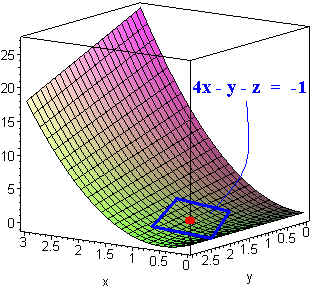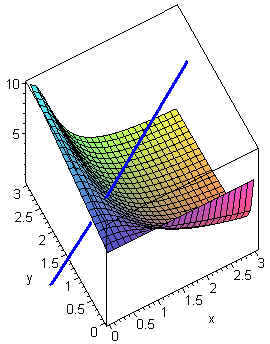1.7: Tangent Planes and Normal Lines
( \newcommand{\kernel}{\mathrm{null}\,}\)
Tangent Planes
Let z=f(x,y) be a function of two variables. We can define a new function F(x,y,z) of three variables by subtracting z. This has the condition
F(x,y,z)=0.
Now consider any curve defined parametrically by
x=x(t),y=y(t),z=z(t).
We can write,
F(x(t),y(t),z(t))=0.
Differentiating both sides with respect to t, and using the chain rule gives
Fx(x,y,z)x′+Fy(x,y,z)y′+Fz(x,y,z)z′=0
Notice that this is the dot product of the gradient function and the vector ⟨x′,y′,z′⟩,
∇F⋅⟨x′,y′,z′⟩=0.
In particular the gradient vector is orthogonal to the tangent line of any curve on the surface. This leads to:
Let F(x,y,z) define a surface that is differentiable at a point (x0,y0,z0), then the tangent plane to F(x,y,z) at (x0,y0,z0) is the plane with normal vector
∇F(x0,y0,z0)
that passes through the point (x0,y0,z0). In particular, the equation of the tangent plane is
∇F(x0,y0,z0)⋅⟨x−x0,y−y0,z−z0⟩=0.
Find the equation of the tangent plane to
z=3x2−xy
at the point (1,2,1).
Solution
We let
F(x,y,z)=3x2−xy−z
then
∇F=⟨6x−y,−x,−1⟩.
At the point (1,2,1), the normal vector is
∇F(1,2,1)=⟨4,−1,−1⟩.
Now use the point normal formula for a plan
⟨4,−1,−1⟩⋅⟨x−1,y−2,z−1⟩=0
or
4(x−1)−(y−2)−(z−1)=0.
Finally we get
4x−y−z=1.

Normal Lines
Given a vector and a point, there is a unique line parallel to that vector that passes through the point. In the context of surfaces, we have the gradient vector of the surface at a given point. This leads to the following definition.
Let F(x,y,z) define a surface that is differentiable at a point (x0,y0,z0), then the normal line to F(x,y,z) at (x0,y0,z0) is the line with normal vector
∇F(x0,y0,z0).
that passes through the point (x0,y0,z0). In Particular the equation of the normal line is
x(t)=x0+Fx(x0,y0,z0)t,
y(t)=y0+Fy(x0,y0,z0)t,
z(t)=z0+Fz(x0,y0,z0)t.
Find the parametric equations for the normal line to
x2yz−y+z−7=0
at the point (1,2,3).
Solution
We compute the gradient:
∇F=⟨2xyz,x2z−1,x2y+1⟩=⟨12,2,3⟩.
Now use the formula to find
x(t)=1+12t,y(t)=2+2t,z(t)=3+3t.
The diagram below displays the surface and the normal line.

Angle of Inclination
Given a plane with normal vector n the angle of inclination, q is defined by
cosq=|n⋅k|||n||.
More generally, if F(x,y,z)=0 is a surface, then the angle of inclination at the point (x0,y0,z0) is defined by the angle of inclination of the tangent plane at the point with
cosq=|∇F(x0,y0,z0)⋅k|||∇F(x0,y0,z0)||.
Find the angle of inclination of
x24+y24+z28=1
at the point (1,1,2).
Solution
First compute
∇F=⟨x2,y2,z4⟩.
Now plug in to get
∇F(1,1,2)=⟨12,12,12⟩.
We have
|⟨12,12,12⟩⋅ˆk|=12.
Also,
||⟨12,12,12⟩||=√32.
Hence
cosq=12(√32)=1√3.
So the angle of inclination is
q=cos−1(1√3)=0.955 radians.
The Tangent Line to a Curve
Find the tangent line to the curve of intersection of the sphere
x2+y2+z2=30
and the paraboloid
z=x2+y2
at the point (1,2,5).
Solution
We find the gradient of the two surfaces at the point
∇(x2+y2+z2)=⟨2x,2y,2z⟩=⟨2,4,10⟩
and
∇(x2+y2−z)=⟨2x,2y,−1⟩=⟨2,4,−1⟩.
These two vectors will both be perpendicular to the tangent line to the curve at the point, hence their cross product will be parallel to this tangent line. We compute
|ˆiˆjˆk241024−1|=−44ˆi+22ˆj.
Hence the equation of the tangent line is
x(t)=1−44ty(t)=2+22tz(t)=5.


